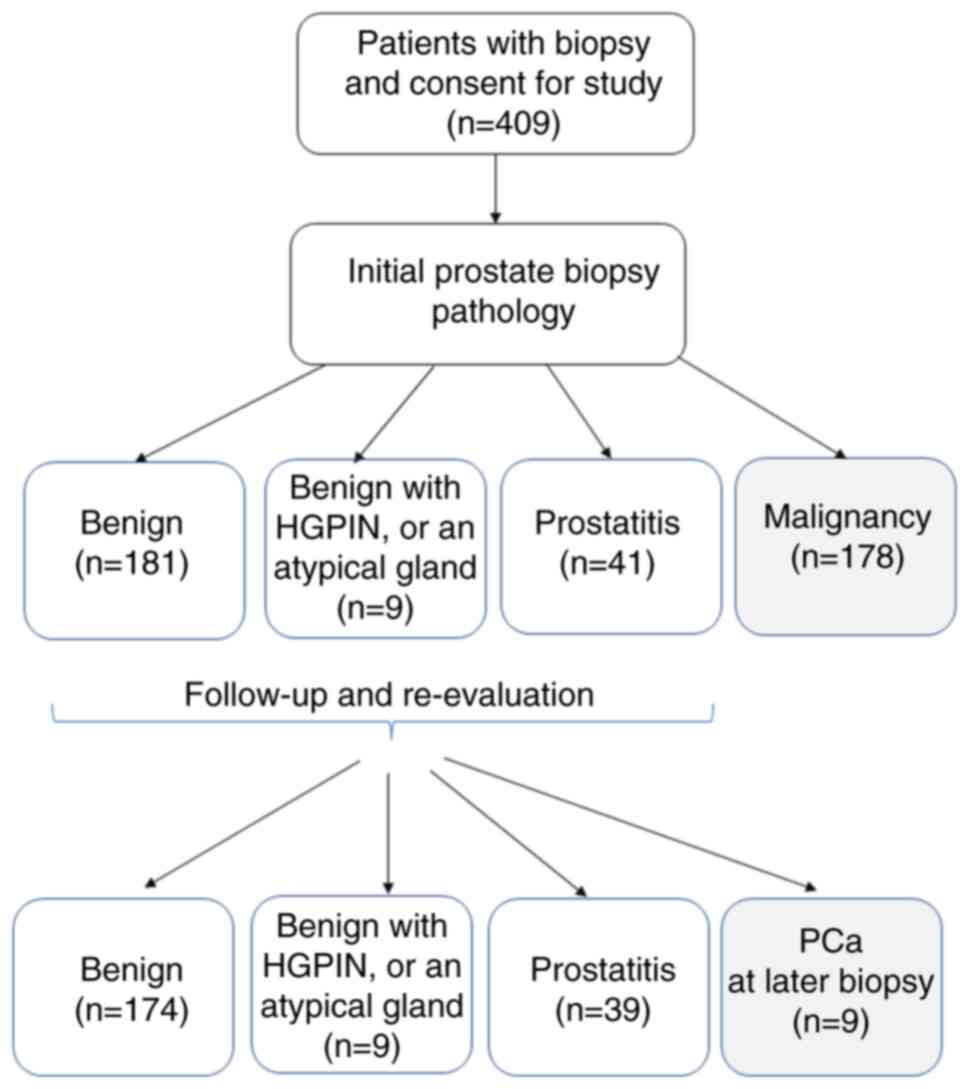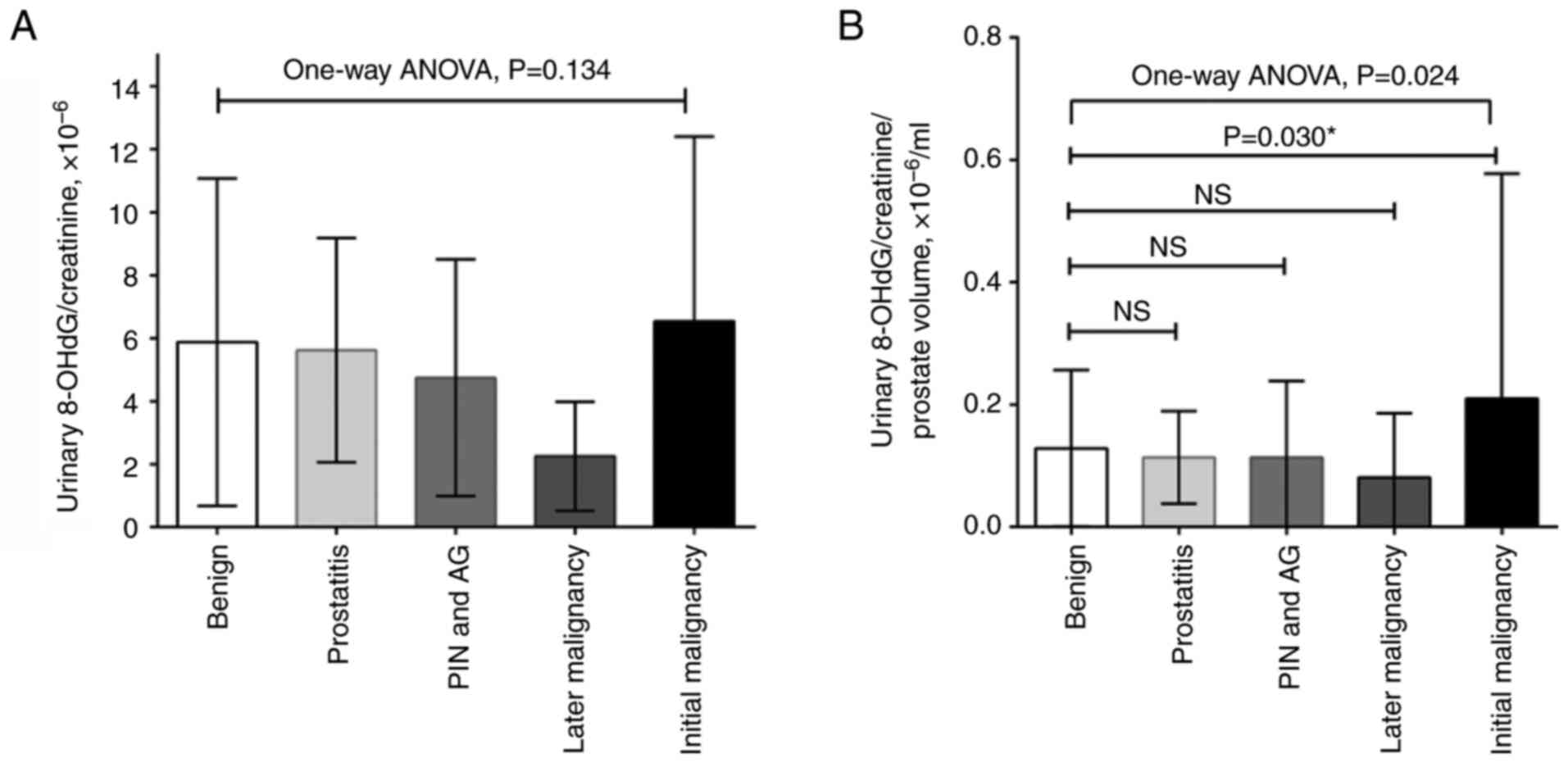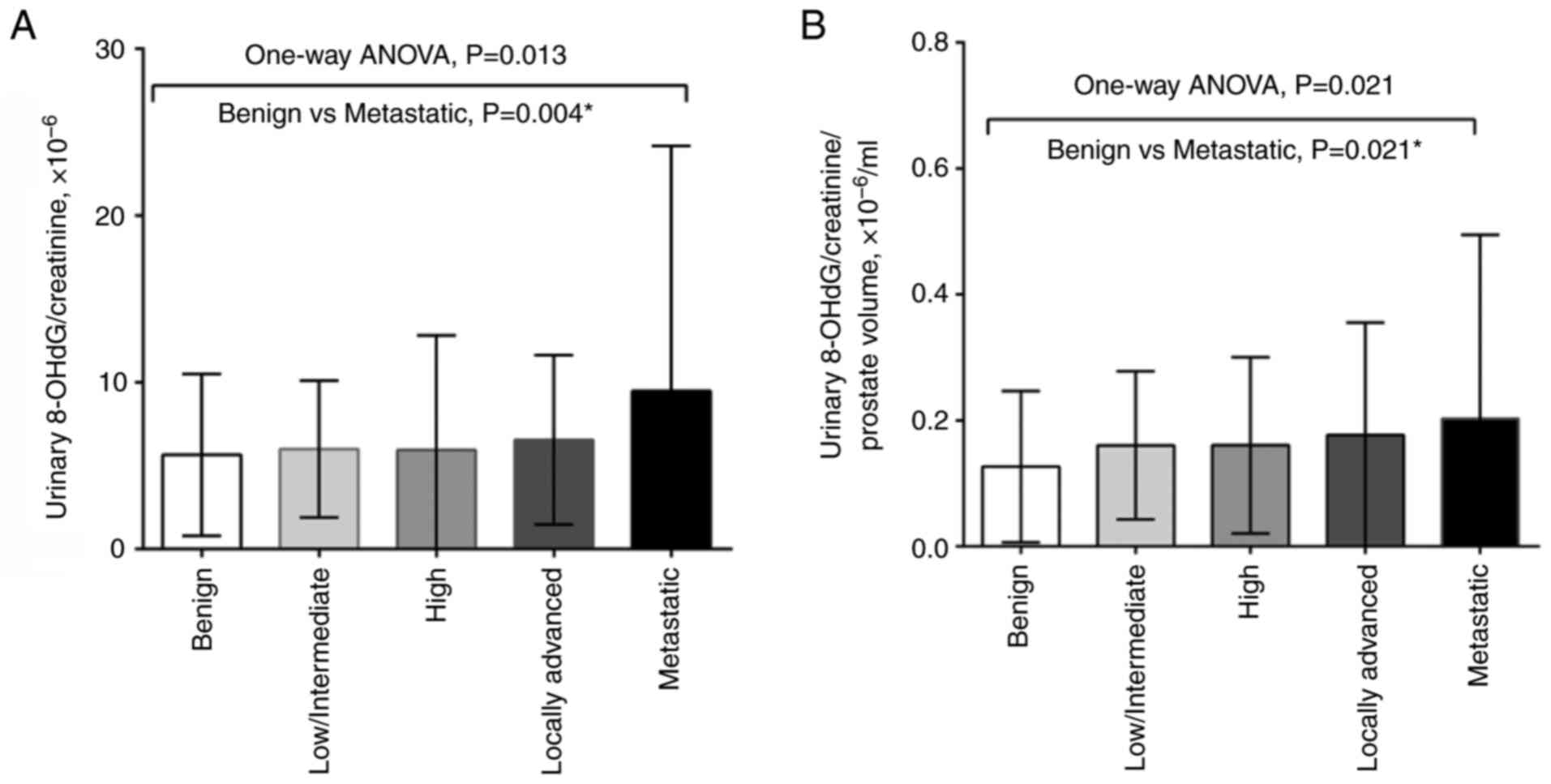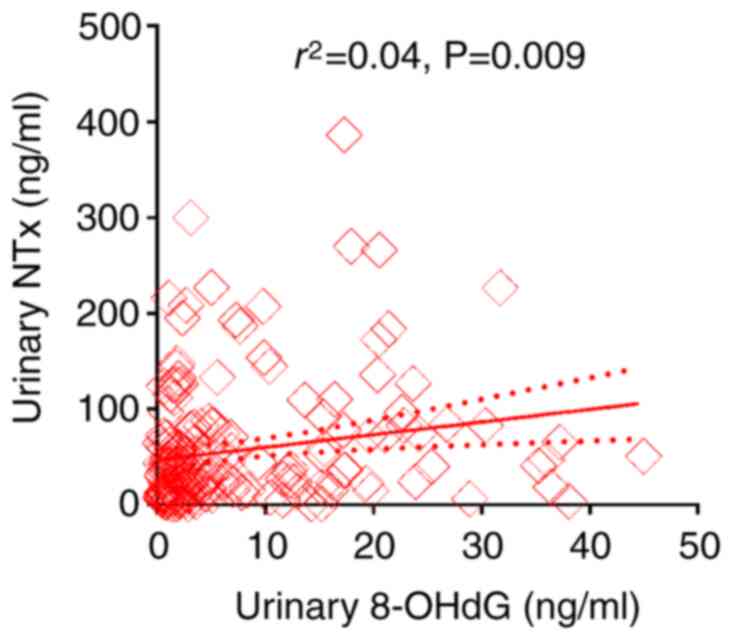|
1
|
Siegel RL, Miller KD, Wagle NS and Jemal
A: Cancer statistics, 2023. CA Cancer J Clin. 73:17–48.
2023.PubMed/NCBI View Article : Google Scholar
|
|
2
|
Health Promotion Administration (HPA):
2022 Health Promotion Administration Annual Report. HPA, Taipei
City, 2022. https://www.hpa.gov.tw/EngPages/Detail.aspx?nodeid=1070&pid=16384.
Accessed 18 May, 2024.
|
|
3
|
Chiang CJ, Lo WC, Yang YW, You SL, Chen CJ
and Lai MS: Incidence and survival of adult cancer patients in
Taiwan, 2002–2012. J Formos Med Assoc. 115:1076–1088.
2016.PubMed/NCBI View Article : Google Scholar
|
|
4
|
Lin YH, Chen KK and Chiu JH: Use of
Chinese medicine among prostate cancer patients in Taiwan: A
retrospective longitudinal cohort study. Int J Urol. 18:383–386.
2011.PubMed/NCBI View Article : Google Scholar
|
|
5
|
Inamoto T, Azuma H, Hinotsu S, Tsukamoto
T, Oya M, Ogawa O, Kitamura T, Kazuhiro S, Naito S, Namiki M, et
al: Age at diagnosis on prostate cancer survival undergoing
androgen deprivation therapy as primary treatment in daily
practice: Results from Japanese observational cohort. J Cancer Res
Clin Oncol. 140:1197–1204. 2014.PubMed/NCBI View Article : Google Scholar
|
|
6
|
Chen PM, Chen SC, Liu CJ, Hung MH, Tsai
CF, Hu YW, Chen MH, Shen CC, Su TP, Yeh CM, et al: The association
between prostate cancer and mood disorders: A nationwide
population-based study in Taiwan. Int Psychogeriatr. 27:481–490.
2015.PubMed/NCBI View Article : Google Scholar
|
|
7
|
Balistreri CR, Candore G, Lio D and
Carruba G: Prostate cancer: From the pathophysiologic implications
of some genetic risk factors to translation in personalized cancer
treatments. Cancer Gene Ther. 21:2–11. 2014.PubMed/NCBI View Article : Google Scholar
|
|
8
|
Huang WK, Liu CH, Pang ST, Liu JR, Chang
JW, Liaw CC, Hsu CL, Lin YC and See LC: Type of androgen
deprivation therapy and risk of dementia among patients with
prostate cancer in Taiwan. JAMA Netw Open.
3(e2015189)2020.PubMed/NCBI View Article : Google Scholar
|
|
9
|
Shukla S, Srivastava JK, Shankar E, Kanwal
R, Nawab A, Sharma H, Bhaskaran N, Ponsky LE, Fu P, MacLennan GT
and Gupta S: Oxidative stress and antioxidant status in high-risk
prostate cancer subjects. Diagnostics (Basel).
10(126)2020.PubMed/NCBI View Article : Google Scholar
|
|
10
|
Drozdz-Afelt JM, Koim-Puchowska BB and
Kaminski P: Analysis of oxidative stress indicators in Polish
patients with prostate cancer. Environ Sci Pollut Res Int.
29:4632–4640. 2022.PubMed/NCBI View Article : Google Scholar
|
|
11
|
Al-Taie A, Sancar M and Izzettin FV:
Chapter 17-8-Hydroxydeoxyguanosine: A valuable predictor of
oxidative DNA damage in cancer and diabetes mellitus. In: Cancer
(Second Edition). Preedy VR and Patel VB (eds). Academic Press, San
Diego, pp179-187, 2021.
|
|
12
|
Li YS, Song MF, Kasai H and Kawai K:
8-hydroxyguanine in urine and serum as an oxidative stress marker:
Effects of diabetes and aging. J Uoeh. 35:119–127. 2013.PubMed/NCBI View Article : Google Scholar
|
|
13
|
Wu LL, Chiou CC, Chang PY and Wu JT:
Urinary 8-OHdG: A marker of oxidative stress to DNA and a risk
factor for cancer, atherosclerosis and diabetics. Clin Chim Acta.
339:1–9. 2004.PubMed/NCBI View Article : Google Scholar
|
|
14
|
Miyaoka T, Ieda M, Hashioka S, Wake R,
Furuya M, Liaury K, Hayashida M, Tsuchie K, Arauchi R, Araki T, et
al: Analysis of oxidative stress expressed by urinary level of
biopyrrins and 8-hydroxydeoxyguanosine in patients with chronic
schizophrenia. Psychiatry Clin Neurosci. 69:693–698.
2015.PubMed/NCBI View Article : Google Scholar
|
|
15
|
Yano T, Shoji F, Baba H, Koga T, Shiraishi
T, Orita H and Kohno H: Significance of the urinary 8-OHdG level as
an oxidative stress marker in lung cancer patients. Lung Cancer.
63:111–114. 2009.PubMed/NCBI View Article : Google Scholar
|
|
16
|
Ohtake S, Kawahara T, Ishiguro Y,
Takeshima T, Kuroda S, Izumi K, Miyamoto H and Uemura H: Oxidative
stress marker 8-hydroxyguanosine is more highly expressed in
prostate cancer than in benign prostatic hyperplasia. Mol Clin
Oncol. 9:302–304. 2018.PubMed/NCBI View Article : Google Scholar
|
|
17
|
Chang WH, Tsai YS, Wang JY, Chen HL, Yang
WH and Lee CC: Sex hormones and oxidative stress mediated
phthalate-induced effects in prostatic enlargement. Environ Int.
126:184–192. 2019.PubMed/NCBI View Article : Google Scholar
|
|
18
|
Moses KA, Sprenkle PC, Bahler C, Box G,
Carlsson SV, Catalona WJ, Dahl DM, Dall'Era M, Davis JW, Drake BF,
et al: NCCN Guidelines® Insights: Prostate cancer early detection,
version 1.2023. J Natl Compr Canc Netw. 21:236–246. 2023.PubMed/NCBI View Article : Google Scholar
|
|
19
|
D'Amico AV, Whittington R, Malkowicz SB,
Schultz D, Blank K, Broderick GA, Tomaszewski JE, Renshaw AA,
Kaplan I, Beard CJ and Wein A: Biochemical outcome after radical
prostatectomy, external beam radiation therapy, or interstitial
radiation therapy for clinically localized prostate cancer. JAMA.
280:969–974. 1998.PubMed/NCBI View Article : Google Scholar
|
|
20
|
Schulz KF, Altman DG and Moher D: CONSORT
Group. CONSORT 2010 statement: Updated guidelines for reporting
parallel group randomised trials. BMJ. 340(c332)2010.PubMed/NCBI View Article : Google Scholar
|
|
21
|
NCCN Clinical Practice Guidelines in
Oncology. Prostate Cancer (Version 4.2024). National Comprehensive
Cancer Network; 2024. Available at: https://www.nccn.org/guidelines/guidelines-detail?category=1&id=1459.
Accessed 24 July, 2024.
|
|
22
|
Paschos A, Pandya R, Duivenvoorden WC and
Pinthus JH: Oxidative stress in prostate cancer: Changing research
concepts towards a novel paradigm for prevention and therapeutics.
Prostate Cancer Prostatic Dis. 16:217–225. 2013.PubMed/NCBI View Article : Google Scholar
|
|
23
|
Liou GY, C'Lay-Pettis R and Kavuri S:
Involvement of reactive oxygen species in prostate cancer and its
disparity in african descendants. Int J Mol Sci.
25(6665)2024.PubMed/NCBI View Article : Google Scholar
|
|
24
|
Biesiadecki M, Mołoń M, Balawender K,
Kobylińska Z and Galiniak S: Shedding light on the shadows:
Oxidative stress and its pivotal role in prostate cancer
progression. Front Oncol. 14(1393078)2024.PubMed/NCBI View Article : Google Scholar
|
|
25
|
Battisti V, Maders LDK, Bagatini MD, Reetz
LG, Chiesa J, Battisti IE, Gonçalves JF, Duarte MM, Schetinger MR
and Morsch VM: Oxidative stress and antioxidant status in prostate
cancer patients: Relation to Gleason score, treatment and bone
metastasis. Biomed Pharmacother. 65:516–524. 2011.PubMed/NCBI View Article : Google Scholar
|
|
26
|
Rossetto IMU, Santos FR, da Silva HM,
Minatel E, Mesquitta M, Salvador MJ, Montico F and Cagnon VHA:
Tempol effect on oxidative and mitochondrial markers in preclinical
models for prostate cancer. Toxicol Res (Camb).
13(tfae056)2024.PubMed/NCBI View Article : Google Scholar
|
|
27
|
Aydin A, Arsova-Sarafinovska Z, Sayal A,
Eken A, Erdem O, Erten K, Ozgök Y and Dimovski A: Oxidative stress
and antioxidant status in non-metastatic prostate cancer and benign
prostatic hyperplasia. Clin Biochem. 39:176–179. 2006.PubMed/NCBI View Article : Google Scholar
|
|
28
|
Oh B, Figtree G, Costa D, Eade T, Hruby G,
Lim S, Elfiky A, Martine N, Rosenthal D, Clarke S and Back M:
Oxidative stress in prostate cancer patients: A systematic review
of case control studies. Prostate Int. 4:71–87. 2016.PubMed/NCBI View Article : Google Scholar
|
|
29
|
Miyake H, Hara I, Kamidono S and Eto H:
Oxidative DNA damage in patients with prostate cancer and its
response to treatment. J Urol. 171:1533–1536. 2004.PubMed/NCBI View Article : Google Scholar
|
|
30
|
Han Q, Gao X, Wang S, Wei Z, Wang Y, Xu K
and Chen M: Co-exposure to polystyrene microplastics and
di-(2-ethylhexyl) phthalate aggravates allergic asthma through the
TRPA1-p38 MAPK pathway. Toxicol Lett. 384:73–85. 2023.PubMed/NCBI View Article : Google Scholar
|
|
31
|
Zhang Y, Yang Y, Tao Y, Guo X, Cui Y and
Li Z: Phthalates (PAEs) and reproductive toxicity:
Hypothalamic-pituitary-gonadal (HPG) axis aspects. J Hazard Mater.
459(132182)2023.PubMed/NCBI View Article : Google Scholar
|
|
32
|
Kumar B, Koul S, Khandrika L, Meacham RB
and Koul HK: Oxidative stress is inherent in prostate cancer cells
and is required for aggressive phenotype. Cancer Res. 68:1777–1785.
2008.PubMed/NCBI View Article : Google Scholar
|
|
33
|
Zhu M, Huang C, Ma X, Wu R, Zhu W, Li X,
Liang Z, Deng F, Wu J, Geng S, et al: Phthalates promote prostate
cancer cell proliferation through activation of ERK5 and p38.
Environ Toxicol Pharmacol. 63:29–33. 2018.PubMed/NCBI View Article : Google Scholar
|
|
34
|
Yong W, Jiao C, Jianhui W, Yan Z, Qi P,
Xiu W, Zuyue S and Yunhui Z: Mono-2-ethyhexyl phthalate advancing
the progression of prostate cancer through activating the hedgehog
pathway in LNCaP cells. Toxicol In Vitro. 32:86–91. 2016.PubMed/NCBI View Article : Google Scholar
|
|
35
|
Virtamo J, Edwards BK, Virtanen M, Taylor
PR, Malila N, Albanes D, Huttunen JK, Hartman AM, Hietanen P,
Mäenpää H, et al: Effects of supplemental alpha-tocopherol and
beta-carotene on urinary tract cancer: Incidence and mortality in a
controlled trial (Finland). Cancer Causes Control. 11:933–939.
2000.PubMed/NCBI View Article : Google Scholar
|
|
36
|
Lonn E, Bosch J, Yusuf S, Sheridan P,
Pogue J, Arnold JM, Ross C, Arnold A, Sleight P, Probstfield J, et
al: Effects of long-term vitamin E supplementation on
cardiovascular events and cancer: A randomized controlled trial.
JAMA. 293:1338–1347. 2005.PubMed/NCBI View Article : Google Scholar
|
|
37
|
Kirsh VA, Hayes RB, Mayne ST, Chatterjee
N, Subar AF, Dixon LB, Albanes D, Andriole GL, Urban DA and Peters
U: PLCO Trial. Supplemental and dietary vitamin E, beta-carotene,
and vitamin C intakes and prostate cancer risk. J Natl Cancer Inst.
98:245–254. 2006.PubMed/NCBI View Article : Google Scholar
|
|
38
|
Heinonen OP, Albanes D, Virtamo J, Taylor
PR, Huttunen JK, Hartman AM, Haapakoski J, Malila N, Rautalahti M,
Ripatti S, et al: Prostate cancer and supplementation with
alpha-tocopherol and beta-carotene: Incidence and mortality in a
controlled trial. J Natl Cancer Inst. 90:440–446. 1998.PubMed/NCBI View Article : Google Scholar
|
|
39
|
Koide S, Kinoshita Y, Ito N, Kimura J,
Yokoyama K and Karube I: Determination of human serum
8-hydroxy-2'-deoxyguanosine (8-OHdG) by HPLC-ECD combined with
solid phase extraction (SPE). J Chromatogr B Analyt Technol Biomed
Life Sci. 878:2163–2167. 2010.PubMed/NCBI View Article : Google Scholar
|
|
40
|
Korkmaz KS, Butuner BD and Roggenbuck D:
Detection of 8-OHdG as a diagnostic biomarker. J Lab Precis Med.
3(95)2018.
|
|
41
|
Qiu SD, Young CY, Bilhartz DL, Prescott
JL, Farrow GM, He WW and Tindall DJ: In situ hybridization of
prostate-specific antigen mRNA in human prostate. J Urol.
144:1550–1556. 1990.PubMed/NCBI View Article : Google Scholar
|













